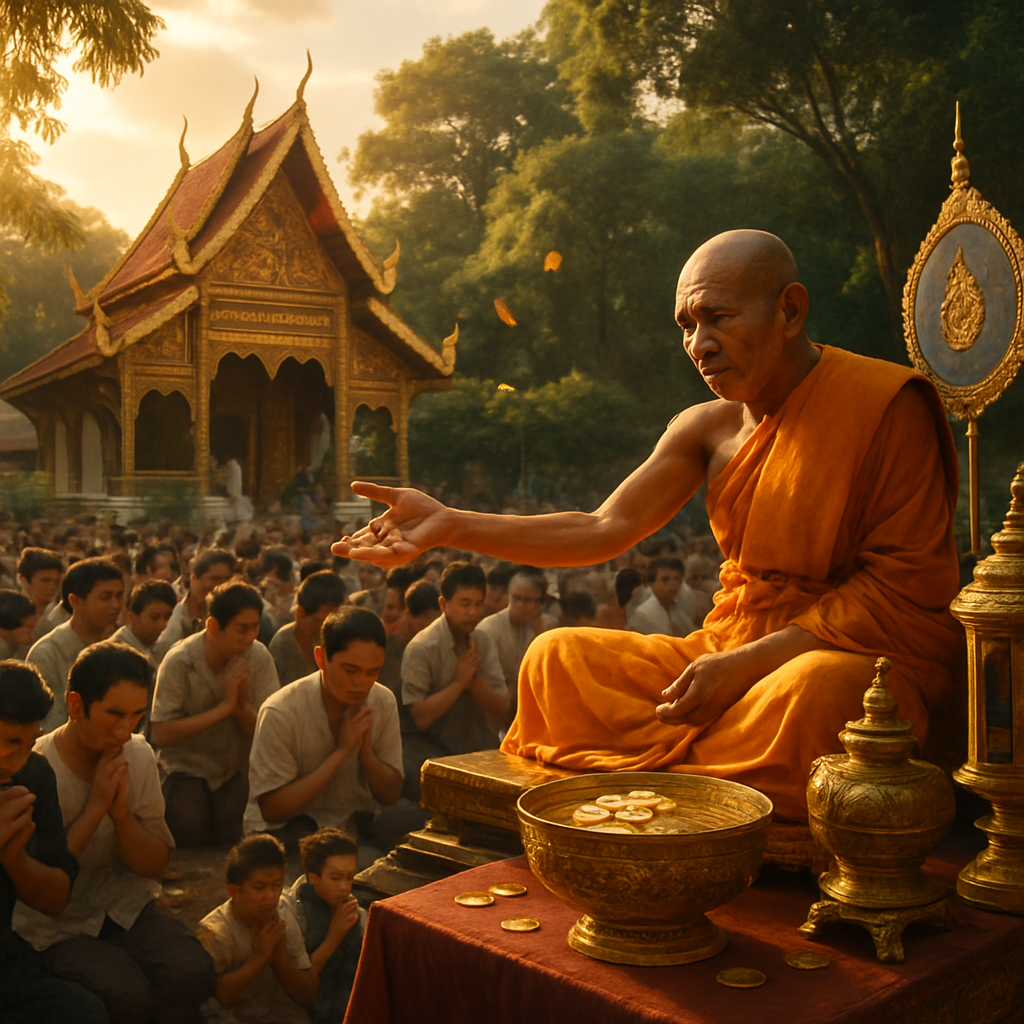In a mesmerizing blend of spirituality and cultural tradition, a large multitude of devotees flocked to Wat Nam Dib for the grand Phutthaphisek consecration ceremony. This enchanting event, held yesterday, April 27, took place in the lush surroundings of the Boonphakdee Buddhist Hall at Wat Chetawanaram, nestled in the serene Nong Pling subdistrict of the Mueang district, Kamphaeng Phet province. The focus of the gathering was the unveiling of the celebrated Chokchai miracle coin, an amulet believed to carry extraordinary blessings, which had already captured the imagination and hearts of many.
Pilgrims and temple-goers united under the guidance of Phra Khru Phalat “Chokchai” Chaiwuttho, whose charismatic presence and spiritual prowess cemented his status as a revered figure. The ceremony stretched over an epic three hours, an immersive experience marked by the rhythmic chanting of nine devoted monks from Wat Bo Sam Saen and Wat Nam Dib. In an atmosphere thick with sacred reverence, these spiritual leaders invoked divine blessings, their melodic prayers resonating with an almost ethereal energy.
The highlight of the ceremony witnessed Phra Khru Phalat Chokchai perched on an elevated platform, surrounded by ceremonial weapons steeped in age-old significance. His dignified poise was reminiscent of times past, embodying the rich tapestry of Thai spiritual tradition. As the ritual unfolded, attendees from Kamphaeng Phet and beyond experienced an unwavering sense of anticipation, all eager to receive the coveted Chokchai miracle coins—a tangible symbol of fortune and protection.
Members of the temple committee, showing commendable organizational skills, deftly handled the throng of eager admirers who had gathered to obtain one of the 500 distributed coins. Such was the allure of the amulets that even before the ceremony’s conclusion, whispers of coin collectors and enthusiasts vying to secure these treasures flooded the air.
The joyous clamour of the gathering was underscored by the transactional buzz surrounding the amulets. The most popular copper coins were available for a humble 300 baht (approximately US$9), while those adorned with a silver mask fetched a premium 1,500 baht (about US$45). Yet, it was the opulent gold mask coins that truly enchanted the crowd, each commanding a princely sum of 5,000 baht (roughly US$150).
In a delightful twist, lottery aficionados were seen closely analyzing the numbers associated with the ritual’s incense and water—hoping against hope for divine intervention in their next lottery draw. This event’s overwhelming turnout and the palpable desire for these amulets speak volumes of the deep-seated faith and conviction woven around these sacred tokens.
Elsewhere in Thailand, curiosity piqued as an ancient Takian tree, thought to be over a millennium old, emerged during the expansion of a water reservoir in Phetchabun province. Dubbed “Chao Mae Ngam Thong” by a local medium, the tree quickly became a beacon for thrill-seekers on the hunt for serendipitous numbers.
With such captivating events unfolding, it’s clear that Thailand is abuzz with a vibrant pulse of spiritual and cultural richness, drawing people together in shared belief and revelry, offering a colorful tableau of modern faith intertwined with ancient traditions.


















I think the obsession with these so-called miracle coins is just superstition at its finest. How can a piece of metal blessed by a monk change your life?
It’s not just a piece of metal. It’s about the faith and belief that people put into these amulets. Faith can indeed be a powerful thing.
I get that faith is important, but paying hundreds for it seems a little too much don’t you think?
I wish I could have attended the ceremony, it sounds beautiful! The spirituality and culture of Thailand are so captivating.
These coins are a collector’s dream! They not only hold spiritual value but also become a part of history.
But doesn’t it bother you that they’re profiting off of people’s beliefs? It’s like mixing commerce with spirituality.
Well, people are willing to pay for these coins. Supply and demand, my friend!
Isn’t that what economies are built on?
I heard the tree in Phetchabun is actually haunted! People say it gives out lucky numbers for the lottery!
Blending the belief in amulets with lottery is sheer genius! It’s the perfect harmony of hope, chance, and fate.
Or it’s just an optimistic thought. Relying on luck for financial success is a dangerous gamble!
The presence of the monks, chanting prayers, creates such a deep ambiance of peace. It’s not about buying luck; it’s about feeling connected.
I respect that. But isn’t connection more of an internal experience than a physical transaction?
True, Ron, but tangible symbols can reinforce our internal beliefs.
That tree in Phetchabun sounds intriguing. A thousand years old? Imagine the stories it could tell.
Yes! Trees are living history books, especially one that ancient. It’s probably seen more than we ever will.
Living in a society where cultural traditions thrive amidst modernity is fascinating. There’s a colorful blend of both worlds in events like these.
I wonder how often these miracle coins actually work. Has anyone here had any life-changing experiences with them?
Yeah, I used one when I applied for my first job, and I actually got it! Coincidence or miracle?
I’d say coincidence.
The pricing of these coins is interesting. I wonder how they determine the value hierarchy among copper, silver, and gold.
It’s a shame how consumerism has infiltrated spiritual practices. Everything is about profit these days.
I don’t know. If selling amulets supports temple maintenance and community services, is it all bad?
Fair point, Paul. As long as the revenue is used for good.
What’s truly amazing is the community gathering part. These events bring people together in search of common hopes and dreams.
To see such a crowd under one belief system warms my heart. It’s powerful how such traditions bring unity.
Unity is great, but critical thinking shouldn’t be left out. Believing blindly isn’t always healthy.